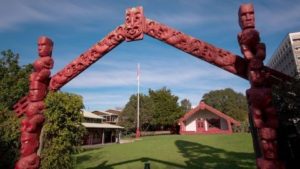Wednesday, February 13, 2019
8.30am – 9.45am
Waipapa Marae, 16 Wynyard Street, Auckland
The Pōwhiri Process At Waipapa Marae, University of Auckland
 Walking on to the marae is a time of remembrance, sadness and showing of respect. Please be silent and reverent throughout the formal Pōwhiri process.
Walking on to the marae is a time of remembrance, sadness and showing of respect. Please be silent and reverent throughout the formal Pōwhiri process.
What to wear
This is a formal process, so it is expected that a tidy smart dress code is required.
What to Do
1. Assemble outside the gate shown in the above photo. You will meet the Kaumatua (Elder for our group) and the kaikōrero (speakers). A kaikaranga (women caller) will briefly explain what to expect, it is also important to stay quiet and not walk in front of her, once we move onto the marae.
2. Move to the gate – women in the front with elder women in the very front, men at the back (and sides). Keep together, and walk behind the kaikaranga.
3. When the kaikaranga (caller) for the tangata whenua (home people) gives her call, our kaikaranga will reply and our group will walk slowly forward, staying behind her and stopping when she stops at about halfway between the gate and the wharenui.
4. When our kaikaranga starts walking forward and there will begin a second call. The call is answered and the group walks on to the porch of the marae where they remove their shoes.
5. You enter the whare (house) and go to the right hand side of the house and remain standing until everyone is assembled inside and until you are asked to be seated by the tangata whenua. The front row must be free for the speakers and male elders only.
6. Once seated, the tangata whenua will open with a karakia (prayer) and himene (hymn). The speeches by the Tangata whenua then take place. As each speech is made, it is followed with a waiata (song).
7. The manuhiri speakers (our speakers) follow with their speeches and waiata (songs). You must stand quietly and try and sing along with our group. (See words/youtube clip below)
8. At the end of the speeches the tangata whenua will indicate to the manuhiri to come forward to shake hands and to hongi (nose pressing, and mixing of the breath and spiritual element). This will only be done by the kaikōrero (speakers) and kaumātua (elders) of our group.
9. Following the speeches, we will then walk up to the conference venue where a karakia will be said and you will share something to drink and eat (there are cultural reasons for this), then once you have completed this part the formal pōwhiri process is complete.
What to Learn
Words and Youtube Clips For the Songs Being Sung at the Powhiri.
Himene: Whakaaaria Mai (https://www.youtube.com/watch?v=YeWtYFsy3Ko)
Whakaaria mai
Tōu rīpeka ki au
Tiaho mai
Rā roto i te pō
Hei kona au
Titiro atu ai.
Ora, mate,
Hei au koe noho ai
Show
your cross to me.
Let it shine
there in the darkness.
To there I
will be looking.
In life, in death,
let me rest in thee.
Waiata 1: Ma Wai Ra (https://www.youtube.com/watch?v=dGF9WMFXpYw)
Ma wai ra e taurima Who will take responsibility
Te marae i waho nei? on the marae now?
Ma te tika, ma te pono There can be justice and truth
me te aroha e only if there is love
Waiata 2: Te Aroha ( https://www.youtube.com/watch?v=uefJdSCkzPo)
Te aroha Love
Te whakapono Faith
Me te rangimarie Peace
Tatou tatou e Be amongst us all
Waiata 3: Maku Ra Pea (https://www.youtube.com/watch?v=VHJ60Nsh9VA)
Maku ra pea Maybe I will
Maku ra pea Maybe I will
Maku koe e awhi e I will guide you
Ki te ara, ara tupu To the pathway, of maturity
Maku koe, e awhi e I will guide you
What to Watch
For those delegates who would like to see a powhiri process please see the following youtube video.
https://www.youtube.com/watch?v=AHq0-Tt0-kk
For those Delegates who are interested in finding out about the history of Waipapa Marae, please see the following Youtube Video. https://www.youtube.com/watch?v=n2n1yK-ixZ4
Glossary
hongi ……………………………………..pressing together of nose and forehead in greeting
kaikaranga ………………………………the woman/women ‘caller’ (tangata whenua side)
kaikōrero ………………………………..the speaker
kaiwhakahoki i te karanga ……………the woman/man ‘caller’ (manuhiri side)
karanga …………………………………..a call
karakia …………………………………..a prayer
kaumātua ………………………………..elder(s) [inclusive of both male and female]
kawa ……………………………………..protocols, rules, procedures
koha ………………………………………a gift/donation [a gesture of appreciation]
manuhiri …………………………………visiting group
marae …………………………………….whole complex, grounds and buildings
marae atea ………………………………ground directly in front of the wharenui [forecourt of the marae]
ope ……………………………………….group
pōwhiri …………………………………..ceremony of welcome
tangata whenua ………………………..home people [people of the marae]
waiata ……………………………………song
wairua ……………………………………spirit
wharenui …………………………………meeting house
wharekai …………………………………dining hall and/or kitchen
